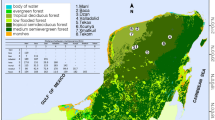Abstract
The nutritional effects of pollen from cassava, oil palm, castor bean, Leucaena leucocephala and a phloem exudate from cassava were tested in the laboratory for their effect on survivorship and oviposition of Amblyseius idaeus (Denmark & Muma). Survival and longevity of even-aged females were enhanced on the aforementioned non-prey diets when compared with the control of no food. Castor bean pollen provided sufficient nutrition to induce an irregular and low ovipositional rate of A. idaeus over a five week interval. Oviposition ceased after 48 h in the presence of the other non-prey foods or free-water only. These studies suggest that A. idaeus is capable of switching or supplementing its diet with non-prey foods during periods when spider mite populations are low.
Similar content being viewed by others
References
BakkerF. and KleinM., 1990. The significance of cassava exudate for predaceous mites. Symp. Biol. Hung., 39: 437–439.
DinhN.V., JanssenA. and SabelisM.W., 1988. Reproductive success of Amblyseius idaeus and A. anonymus on a diet of two-spotted spider mites. Exp. Appl. Acarol., 4: 41–51.
FrieseD.D., MégevandB. and YaninekJ.S., 1987. Culture maintenance and mass production of exotic phytoseiids. Insect Sci. Applic. 8: 875–878.
JamesD.G., 1989. Influence of diet on development, survival and oviposition in an Australian phytoseiid, Amblyseius victoriensis (Acari: Phytoseiidae). Exp. Appl. Acarol., 6: 1–10.
KennettC.E., FlahertyD.L. and HoffmanR.W., 1979. Effect of wind-borne pollens on the population dynamic of Amblyseius hibisci (Acarina: Phytoseiidae). Entomophaga, 24: 83–98.
McMurtry, J.A., 1982. The use of phytoseiids for biological control: progress and future prospects. In: M.A. Hoy (Editor), Proc. Conf. Recent Advances in Knowledge of the Phytoseiidae. Univ. Calif. Div. Agric. Sci. Publ., 3284: 23–48.
McMurtryJ.A., 1992. Dynamics and potential impact of “generalist” phytoseiids in agroecosystems and possibilities for establishment of exotic species. Exper. Appl. Acarol., 14: 371–382.
McMurtryJ.A. and JohnsonH.G., 1965. Some factors influencing the abundance of the predaceous mite Amblyseius hibisci in southern California (Acarina: Phytoseiidae). Ann. Entomol. Soc. Am., 58: 49–56.
McMurtryJ. A. and RodriguezJ. G., 1987. Nutritional ecology of phytoseiid mites. In: F.SlanskyJr. and J. G.Rodriguez (Editors), Nutritional Ecology of Insects, Mites, Spiders, and Related Invertebrates, Wiley-Interscience, New York, pp. 609–644.
McMurtryJ.A. and ScrivenG.T., 1964. Studies on the feeding, reproduction and development of Amblyseius hibisci (Acarina: Phytoseiidae) on various food substances. Ann. Entomol. Soc. Am., 57: 649–655.
OvermeerW.P.J., 1985. Alternative prey and other food resources. In: W.Helle and M.W.Sabelis (Editors), Spider Mites, their Biology, Natural Enemies and Control. Vol. 1B. Elsevier, Amsterdam, pp. 131–139.
RamakersP.M.J., 1980. Biological control of Thrips tabaci (Thysanoptera: Thripidae) with Amblyseius spp. (Acari: Phytoseiidae). SROP/WPRS Bull. 3: 203–207.
SwirskiE., AmitaiS. and DorziaN., 1967. Laboratory studies on the feeding, development and reproduction of the predaceous mites Amblyseius rubini Swirski and Amitai and Amblyseius swirskii Athias (Acarina, Phytoseiidae) on various kinds of food substances. Israel J.Agric. Res. 17: 101–119.
Tanigoshi, L.K., 1982. Advances in knowledge of the Phytoseiidae. In: M.A. Hoy (Editor), Proc. Conf. Recent Advance in Knowledge of the Phytoseiidae. Univ. Calif. Div. Agric. Sci. Publ. 3284: 1–22.
TanigoshiL.K., FargerlundJ. and Nishio-WongJ. Y., 1981. Significance of temperature and food resources to the developmental biology of Amblyseius hibisci (Chant) (Acarina, Phytoseiidae). Z. Ang. Ent. 92: 409–419.
YaninekJ.S. and HerrenH.R., 1988. Introduction and spread of the cassava green mite, Mononychellus tanajoa (Bondar) (Acari: Tetranychidae), an exotic pest in Africa and the search for appropriate control methods: a review. Bull. Entomol. Res. 78: 1–13.
YaninekJ.S., MégevandB., MoraesG. J.De, BakkerF., BraunA. and HerrenH. R., 1991. Establishment of the neotropical predator Amblyseius idaeus (Acari: Phytoseiidae) in Benin, West Africa. Biocontrol Sci. Tech., 1: 323–330.
ZhimoZ. and McMurtryJ.A., 1990. Development and reproduction of three Euseius (Acari: Phytoseiidae) species in the presence and absence of supplementary foods. Exp. Appl. Acarol. 8: 233–242.
Author information
Authors and Affiliations
Rights and permissions
About this article
Cite this article
Tanigoshi, L.K., Mégevand, B. & Yaninek, J.S. Non-prey food for subsistence of Amblyseius idaeus (Acari: Phytoseiidae) on cassava in Africa. Exp Appl Acarol 17, 91–96 (1993). https://doi.org/10.1007/BF00156946
Issue Date:
DOI: https://doi.org/10.1007/BF00156946




